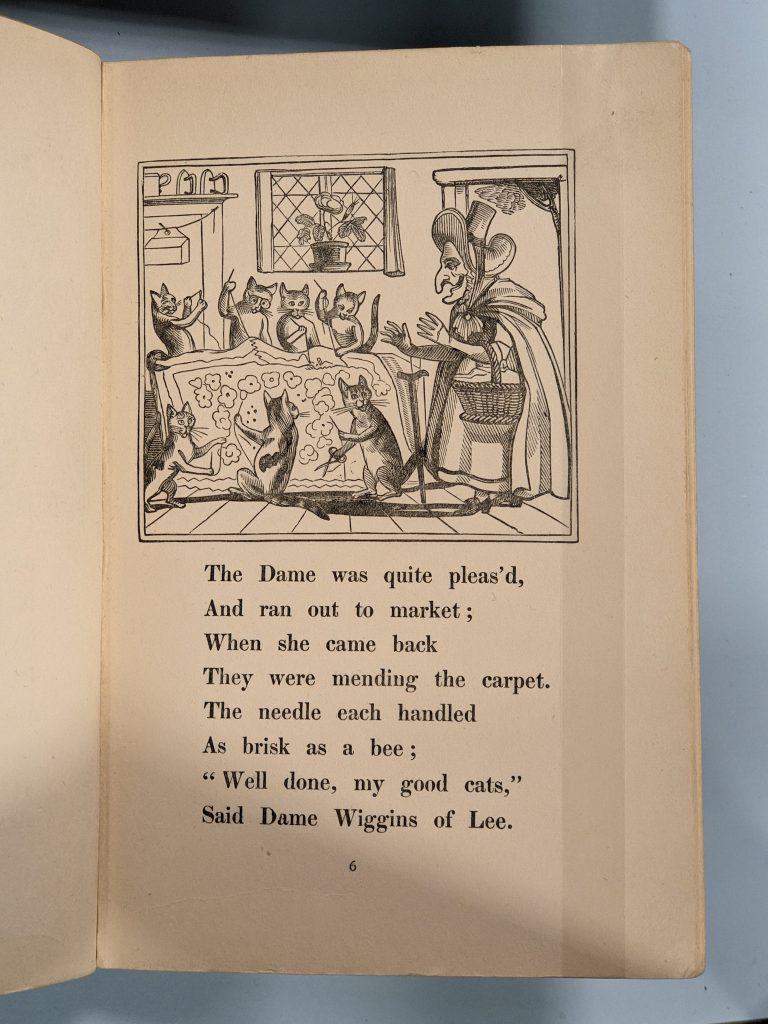Numbered from top to bottom, left to right
One: Feline Friends: Cats in Children’s Literature — From the Dorothy Neal White Collection and the National Children’s Collection
People and cats have lived together for thousands of years, from the time when cats provided a rodent hunting service for early farming communities.
In modern times our relationship with cats has developed into a much closer emotional bond. Although one of the cat’s most notable characteristics is independence, they are devoted and trusting companions for their chosen humans. These children’s stories range from the realistic to the fantastical, and their cat characters show some of our feline friends’ most familiar traits: adventurousness, stealth, feistiness, opportunism and love of a cosy home.
Two: A story in rhyme about the clever, kind and comical deeds of a woman’s seven cats. Among their many accomplishments are ice-skating, mending a carpet, singing, and taking care of a sick lamb.
Dame Wiggins of Lee and her seven wonderful cats: a humorous tale. Written principally by a lady of ninety ; edited, with additional verses, by John Ruskin ; and with new illustrations by Kate Greenaway, with twenty-two woodcuts.
London: George Allen & Unwin
1926 (first published: London: A.K. Newman & Co., 1823)
Three: A quick-witted and clever cat contrives for his poor master, a miller’s son, to end up living in a castle and marrying the king’s daughter. Marcia Brown (1918-2015) completed both the translation and illustrations for this version of Puss in Boots. Brown is one of only two artists to have won three Caldecott Medals, and she also illustrated six Caldecott Honor Books, of which this is one.
Brown, Marcia. Puss in Boots: a free translation from the French of Charles Perrault.
New York: Charles Scribner’s Sons
1952
(Caldecott Honor Book, 1953)
Four: A fantastical creature who can appear and disappear at will, the Cheshire Cat is surely one of literature’s most famous felines. To “grin like a Cheshire Cat” was already a common phrase before Lewis Carroll used it as the basis for this character, but its exact origins are not clear. One of the most appealing theories is that, because of the number of dairy farms in Cheshire, the cats grin because there is so much milk and cream.
Carroll, Lewis. Alice’s adventures in Wonderland. Illustrated by John Tenniel.
London: Macmillan
1984.
(Facsimile of an edition published by Macmillan in 1866)
Five: The books on display
Six: T.S. Eliot’s much-loved collection of cat poetry was originally written to entertain his god-children, and later found fame as a stage musical.
Eliot, T.S. Old Possum’s book of practical cats. Illustrated by Nicolas Bentley.
London: Faber and Faber
1940 (1962 reprint)
Seven: Sid has cleverly organized a perfect life for himself, living in six different houses and eating six different dinners every day. But one day, after six trips to the vet, he is found out!
Moore, Inga. Six dinner Sid.
London: Simon & Schuster
1990
Eight: Tom, a three-legged tabby cat, lives a quiet life with respectable Mrs Gimble, but he longs to prowl around the world. Tom’s yen for adventure is satisfied when there is a fortuitous mix-up between him and a somewhat tatty hat belonging to Mrs Gimble’s swagman brother, Cyril.
Mahy, Margaret. The three-legged cat. Illustrated by Jonathan Allen.
London: Puffin
1994
Nine: Feline Friends: Cats in Children’s Literature — From the Dorothy Neal White Collection and the National Children’s Collection
People and cats have lived together for thousands of years, from the time when cats provided a rodent hunting service for early farming communities.
In modern times our relationship with cats has developed into a much closer emotional bond. Although one of the cat’s most notable characteristics is independence, they are devoted and trusting companions for their chosen humans. These children’s stories range from the realistic to the fantastical, and their cat characters show some of our feline friends’ most familiar traits: adventurousness, stealth, feistiness, opportunism and love of a cosy home.
Ten: A collection of four stories featuring two of Lynley Dodd’s most beloved cat characters. Slinky Malinki is the “stalking and lurking adventurous cat”, known in particular for his ambitious acts of theft around his neighbourhood. Scarface Claw is “the toughest tom in town”, always ready to stir up trouble with cats and dogs alike. (Stories in the collection are: Slinky Malinki ; Slinky Malinki, open the door ; Slinky Malinki catflaps ; Scarface Claw).
Dodd, Lynley. Cat’s whiskers: four favourite Lynley Dodd stories.
Wellington, N.Z.: Mallinson Rendel
2003
— Mary Skarott, Research Librarian, Children’s Literature









